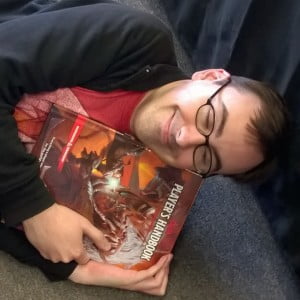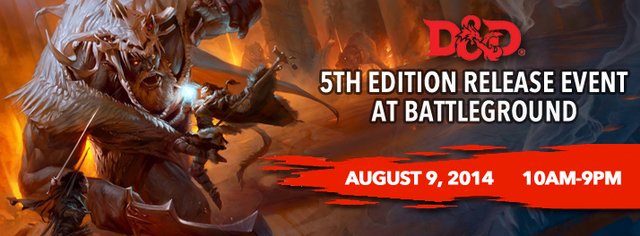Posts Tagged ‘Player’s Handbook’
D&D Next Player’s Handbook: Initial Reaction by Sam Pearson
Tuesday, August 12th, 2014

As many of you might know, I get excited about things. That’s kind of my job. But even I wasn’t prepared for what the 5th edition Player’s Handbook for Dungeons & Dragons did to me. Never before have I been such a roiling vortex of anticipation, wringing Twitter dry for each precious drop of information leading up to the release. You could have held a match to me, and it would have ignited. I was being held back from joy by the cruel, unrelenting slowness of time.
The book is out. I’m better now.
So let’s take a look at what patience and agony have bestowed upon us. Let’s see the PHB!
The Look
The first thing you’ll notice about the new Player’s Handbook is the art. You can’t escape it; it’s glorious. From the first glimpse of King Snurre’s rage on the front cover, to the paradigm-shattering sword-and-board fighter on page 148 (seriously, look it up), to page 191’s epic confrontation, the art draws you in and holds you. The style is unique, and every image evokes a whole universe of stories. Do yourself a favor and just page through once to look at the pretty pictures. Even if you’re a die-hard rules fan, it’s time well spent.
The Rules
Okay, this is the big one. I’ve heard the question a lot over the past year: “How do the new rules stack up?” The answer is: amazingly well. Gone are the restrictions of 4e, limiting players to a short list of powers and a gridded combat area. Gone is the arms race of 3.5, with players quickly outpacing any challenge the DM might be able to conjure. Derek calls 5e the best edition, and I agree. Let’s talk about why.
First, it’s easy. The core mechanic revolves around ability checks: roll a d20 and add a modifier from one of the six ability scores. That’s familiar ground for most D&D players, and takes five seconds to explain to anyone just starting with the game. There’s also a mechanic called advantage/disadvantage. Say you make an attack roll against an orc wearing a blindfold (who doesn’t happen to be a kung-fu master or something). You would make the roll with advantage: you roll two d20s and take the higher of the two to determine your result. It’s easy, effective, and intuitive. Conversely, say you’re attacking an orc while YOU wear the blindfold. Now you roll with disadvantage: roll two d20s and take the lower roll.
Show of hands. Who figured out what disadvantage was before I got to the end of that sentence? It’s such a simple concept, but anyone who sits down to play immediately grasps that advantage is something you want, and disadvantage is something you want to avoid like a huggy fire elemental. The mechanic also neatly addresses the problem of mountains of stacking bonuses. In 5th edition, you almost never have an ability score above 20. Without rare magic or twenty levels in barbarian, you simply can’t. This means that a check with a DC of 20 is always a difficult thing, even for high level characters. You never say “I smash through the iron door with my face. I don’t need to roll.” 5th edition has taken the sweet spot of 3.5, that fifth to tenth level range, and expanded that feeling to cover the entire play experience.
All right, on to the second big benefit of D&D Next: magic feels like magic. One of the big issues with 4e for a lot of players was that spells were just powers like any other. A fighter attacking everyone within two squares felt very similar to the wizard spraying fire in all directions; the mechanics were largely the same. But even 3.5, and by extension Pathfinder, made magic feel mundane. “Oh, look, another +1 sword. Shame I have a better one already. I guess we’ll sell it back in town.” I don’t know about you, but I feel like finding a magic item should never be boring. Magic should be wondrous. It should be a cut above the ordinary, a way to go beyond the normal framework of life. 5th edition brings back that wonder.
Spells slots are back, for a start. Powerful magic is a limited resource. But cantrip spells can be cast freely, all day, every day, so a wizard never becomes just some goofball in a pointy hat. And magic items are a big, big deal. They can’t be bought, for a start. You’re not going to find a store full of fabulous arcane equipment in every random village, and even large cities won’t have a magical emporium. If you want a +1 longsword, you go to a library, research King Arthur, puzzle out the final resting place of Excalibur, and go fight zombie knights until you can wrest your prize from the cold grasp of a long-dead king. And if you get tired of it, good luck selling it! Dropping that down in a general store and asking for coin would be like paying for your gum at a gas station using a gold brick. These items should be strange and wonderful, and the system is designed with that in mind. No longer is it assumed that a fifth level character has at least a +1 weapon and some magic armor; you can go all the way to level twenty without ever needing enchanted equipment. That just makes it all the better when you do find it.
The Mindset
Quite apart from the rules, the biggest change in D&D Next is one of approach. Wizards of the Coast has given us a Player’s Handbook that meets us halfway, or more than halfway; these are tools to tell your own stories. There’s a list of gods in an appendix for several campaign settings, including historical Earth (yes, you can be a cleric of Zeus). There are quotations, pictures, and references to the Forgotten Realms, Greyhawk, and Dragonlance throughout the book. Advice is given on how to make characters come to life, since roleplay is now as important a part of the system as combat, but the book always gives you options, never mandates. With this Player’s Handbook, Wizards of the Coast isn’t saying “Here’s our game, take it or leave it.” They have made it abundantly clear that this is our game, to play as we wish. 5th edition will never tell you that you’re having fun wrong.
As you read through the book, options abound. Strange races like dragonborn are there, but it’s explicitly mentioned that they may not fit all campaign settings. Feats exist (and are amazing), but are an optional component; you don’t have to have a twenty-level feat progression just to play the game, and it works fine without them. Each and every class has two or more different variants, from the many schools of magic for wizards to the different paladin oaths, providing extensive character customization. A party of five fighters can be as varied as any other, and still be quite effective.
And the options aren’t limited to the player’s side of the screen. D&D Next returns to an emphasis on DM rulings, not rules. The system gives DMs simple tools to describe and adjudicate any situation, then quietly lets you get on with it. One upshot of this method is compatibility: with appropriate monster conversions, you can run any adventure from any version of D&D or Pathfinder, converting the encounters on the fly. I’ve done it with the Tomb of Horrors and Expedition to the Barrier Peaks, running both straight out an AD&D 1st edition reprint. And with the Monster Manual coming out in September with its monster creation rules, and the Dungeon Master’s Guide in November with a whole host of options to hack the game for whatever you want to do, D&D Next will give us more freedom to play the game we want than we’ve ever had before.
Final Thoughts
I could go on. If we were standing around at the Plainville store, I probably would. I would talk about the beautifully simple spell preparation system. I’d tell you why fighters are better fighters than anyone else. I’d tell you why I want to play every single class in the whole Player’s Handbook, or how to make a dwarf wizard in armor, or how to know seven languages at level one. But all of that is just wasting time. The rules are out there, and as a wise man once said, you don’t have to take my word for it. I’ve found my favorite D&D, and maybe you will, too.
About the author
Sam is a passionate gamer who obviously loves his Dungeons and Dragons (see photo above). When he is not playing games he can be found working on his next novel. Did we mention he also works for Battleground Games & Hobbies? He does!
Join the Battleground Games & Hobbies community forums!
Please don’t forget to check us out on Facebook and follow us on Twitter @battleground_gh!
Tags: DND, dnd 5th edition, dnd next, Dungeons and Dragons, Player's Handbook, sam pearson
Posted in Blog, Dungeons & Dragons, Featured Author, Featured Post, Popular Posts, Role-Playing Games | 4 Comments »
D&D 5th Edition Player’s Handbook Has Arrived!
Thursday, August 7th, 2014
The wait is over! The highly anticipated ‘Dungeons & Dragons’ 5th Edition Player’s Handbook has arrived at Battleground Games & Hobbies! This brand new D&D products is “…everything a player needs to create heroic character for the world’s greatest role-playing game [‘Dungeons & Dragons’].”
From the Wizards of the Coast official product page:
“The Player’s Handbook is the essential reference for every Dungeons & Dragons role-player. It contains rules for character creation and advancement, backgrounds and skills, exploration and combat, equipment, spells, and much more. Use this book to create exciting characters from among the most iconic D&D races and classes.
Dungeons & Dragons immerses you in a world of adventure. Explore ancient ruins and deadly dungeons. Battle monsters while searching for legendary treasures. Gain experience and power as you trek across uncharted lands with your companions.
The world needs heroes. Will you answer the call?”
All you have to do to answer the call is visit your local Battleground Games & Hobbies in either Abington, MA or Plainville, MA and pick up your copy today; or visit us online and have a copy of this amazing new book delivered right to your front door!
Plus, please don’t forget to join us at Battleground Games & Hobbies on August 9th for the D&D 5th Edition Release event beginning at 10:00 AM and celebrate the release of the brand new Player’s Handbook!
Tags: 5th edition, D&D, D&D Next, Dungeons & Dragons, New Release, Next, Player's Handbook, Wizards of the Coast
Posted in Blog, Board Games, Dungeons & Dragons, Events, Featured Post, Role-Playing Games, Store Related | No Comments »
- Products
- Buylist
- Policies
- Contact Us






Social: